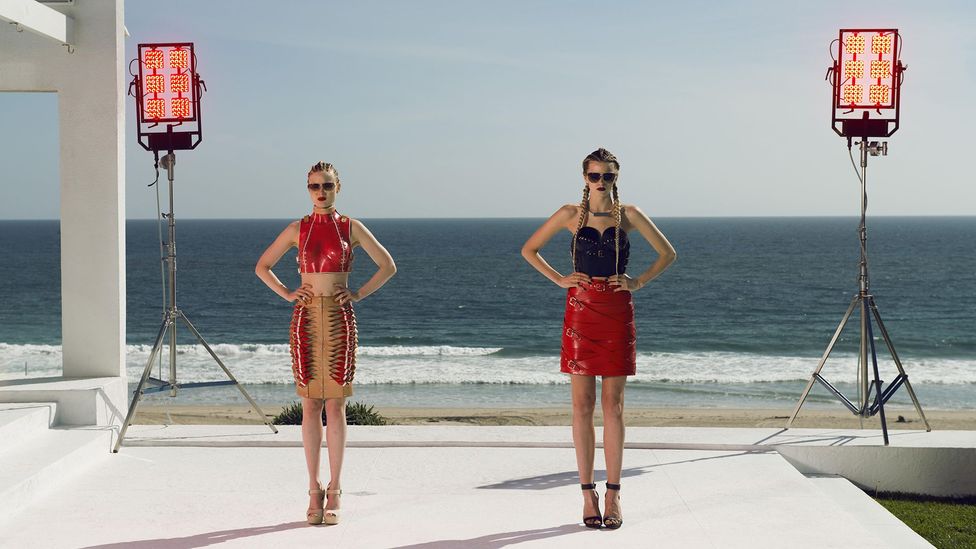*CW: mentions of murder, attempted rape, necrophilia and cannibalism*
In the opening shot of The Neon Demon, Elle Fanning’s character, Jesse, is sprawled onto a metallic-coloured sofa, her face adorned with multicoloured crystals, her eyes wide open and tributaries of blood cascading down her arm. Her throat is torn and mouth agape in shock. From the get-go, one can understand that she is like a mannequin, even in this constructed death. Adorned in a metallic blue dress, she doesn’t look like a real human being. We zoom out of the scene, only to see a male photographer gazing at her from a distance with a look of hunger — or even lust.
This is a common scene throughout American entertainment and literature, this morbid fascination with dead girls. Our main character is immediately dehumanised from the opening shot of the film. She is a lifeless doll, hands limp and draping over the armchair, being told what to do by the only other figure in the room, a much older man. She has lost all agency to the male gaze.
Jesse is sixteen years-old and an orphan from Georgia. An aspiring model looking to make it in the fashion world, she is originally clothed in modest attire during her shoots and everyday life. She is innocent in nature and a bit naïve, making her a prime target for predators. One can tell she is not like the other girls trying to model, who ask about her sexual pursuits. The first time she meets her fellow models, they pose a question to her: is she food or is she sex? Jesse’s destiny seems to lie in one of these labels. This is a precursor to what is to come; she will literally become both food and sex, to be devoured in a visual and physical sense.
As Jesse continues to rise through the ranks of the industry, there is a slow transformation of her character. While at the beginning she is shot in frilly white and pastel dresses with minimal makeup, the male photographers make her dance with the lights of Los Angeles as her backdrop. A shift is marked during a photoshoot with strobe lights, as her fellow models are dressed quite plainly, but Jesse has been dressed in a braided up-do and a high-neck black dress that illuminates with the flashing lights.
She is clearly meant to stand out and is seen as different from the others. This is a pivotal moment in the film, one that distinguishes how her personality changes from this moment onwards. There is a shift in the colouring of the film, one where the soft hues and pastels are replaced with darker, more threatening neons of violet, blue, red, and black. Jesse, while illuminated in red, begins to kiss her reflection. Her attire, too, begins to change after this moment. She is now dressing in cuts deemed more sexy by societal standards, with dark eyeshadow and eyeliner, deep v-necks, her pale skin exposed.
To have seemingly made it in this industry, according to the world of The Neon Demon, one must sacrifice their youth and innocence to become successful. These women are clambering over each other, literally killing and devouring their friends in the name of having made it. While female bodies can be adorned with clothing to become pieces of art in the film, they are also dismantled and systemically destroyed in this ritualistic cult of beauty. Evoking images of witchcraft and the occult in the tattoos and clothing the characters are adorned in, they are merely reduced to historical images that are used to negatively depict women.
After the first arc of the film, the simplicity of the feminine body is hyper-sexualised and put in a place of excess. Stripped bare in bras, underwear, and heels for an audition, that marks a departure from the beginning of the film. After the fashion show, the designer, Sarno (Alessandro Nivola), degrades women who’ve had plastic surgery, specifically calling out Gigi (Bella Heathcote) as she sits in front of him. He praises natural beauty, then mockingly says “Oh, so is it what’s inside that truly counts? Beauty is the only thing.” As these women continue to navigate through this world, they continue to go to extremes in order to stand out and truly be considered beautiful in the eyes of the male gaze. Although they are uncomfortable with Sarno’s remarks, they still clamor for his attention so they, too, have a shot at getting to the top.
They are stripped of their identity and ranked in their placement of the world based on their appearance. We see very few models of colour throughout these elaborate photoshoots and fashion shows, implying that often like the actual fashion industry, there is a sense of racist beauty standards, deliberately keeping out models of colour and promoting a Euro-centric view of beauty. Our main cast is all white, pale, and blonde. They are also not truly living; they are walking corpses, ones who exist to look ethereal and be fetishized, as seen in the bondage gear the models are dressed in towards the end of the film.
While intending to be constructive criticism on how the modeling industry works in regards to women, The Neon Demon upholds and maintains the male gaze with its imagery. Ruby tries to have sex with Jesse, although Jesse demands her to stop, as Ruby desperately breathes out that she wants to be the one to break Jesse’s virginity. Then, as Ruby engages in necrophilia, the scene cuts back and forth between that and Jesse touching herself. After Jesse’s murder, there is an drawn-out scene where we see all of the models washing blood off while naked, and they’re sensually rubbing their hands all over their bodies. The camera perversely lingers in these scenes, drinking it all in.
As the cast of characters are adorned in fancy clothes and pristine makeup and hairstyles, they seem almost soulless at times. This is seen at the end of the film, when the other models murder Jesse and consume her body. Showing no remorse for what they’ve done, they continue to clamor for positions in photoshoots, until Gigi throws up one of Jesse’s eyeballs and kills herself out of regret. Still, her companion shows no emotion as Gigi lays dying in front of her, instead turning around and going back to the photoshoot as if nothing happened.
The film is a fairy tale of glamour and violence, taking women’s bodies and cranking up the fetishization. It doesn’t try to be a feminist film. It’s a horror film about beauty. But, at the end of the day, it is undeniable from the depictions of women’s bodies that this isn’t a female director behind the camera, with the lens also reinforcing the male gaze, providing an even more sinister undertone to the orchestrated events unfolding on the screen.
by Ashley Hajimirsadeghi
Ashley Hajimirsadeghi is a multimedia artist and writer. A graduate of the Fashion Institute of Technology, her research areas include urbanism, material culture, gender studies, and digital spaces. More of her work can be found at ashleyhajimirsadeghi.com




Leave a comment